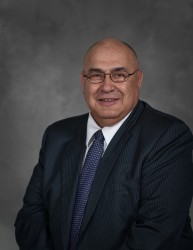Article Origin
Volume
Issue
Year
A report released on Dec. 16 by the Child and Welfare ministry panel titled ‘For the Good of Our Children and Youth’ presented 12 recommendations to solve some of the issues prevalent in the child welfare system.
The report recognizes the important decision-making role of First Nations and Métis leaders in the system, as Aboriginal children represent approximately 80% of those in care across the province.
At a press conference on Dec. 20, Federation of Saskatchewan Indian Nations Vice Chief Dutch Lerat, Chief of Sturgeon Lake First Nation Wesley Daniels, and Ray Shingoose of the Yorkton Tribal Council Child and Family Services shared their reactions to the report with media.
“The indicators of why these children come into care is based on child poverty, substance abuse, substandard housing, and witness to family violence… the main one is neglect,” Shingoose said. “This is a common area that we need to seriously look at on-reserve and off-reserve.”
Shingoose added that as an ICFS program worker he believes the importance is in working with the family and keeping the focus on the child. He also said the challenge is getting the two child welfare systems, one run by the province and the other by First Nations bands or tribal councils, to work together as one.
“To complement each other, find the common ground and move from there,” said Shingoose.
Chief Lerat said the target area of First Nations leaders is preventing children from coming into the foster care system through programs that build healthy families and homes for First Nations children.
“The majority of families considered at-risk today are a result of families broken by the residential school system,” said Chief Lerat. “Our collective approach needs to address how we are going to help these parents and the children of these parents so the cycle does not continue.”
Chief Lerat said there are parents today who did not experience the love of their mothers and fathers as they were forcibly removed from their families and placed in residential schools.
They did not have the opportunity to learn appropriate parenting skills from their parents, Lerat said. He added that the main obstacle as identified in the report is the lack of commitment and underfunding to make the change that directly improves the lives of families-at-risk.
“The funding for prevention services is limited and we continue to advocate for more needs-based funding to be provided in order to improve the delivery of prevention services on reserve,” he said.
Chief Lerat stated that prevention is not case-based on reserve but program-based.
“It’s less threatening for families to come and accept the help that they may need, whether it’s parenting classes, or criminal child health workshops or support groups for mental health, addictions,” he added.
The collective approach must address the issues of poverty, of jobs, and a sense of purpose that comes along with employment, as well as counseling, education, dealing with mental health and addictions, said Chief Lerat.
“It is time for First Nations voices to be heard in order to help implement the change that needs to happen for our children,” he added. “Where do we go from here, that will be the challenge. But we are hopeful that it will be a better tomorrow for our children.”
The report’s twelve recommendations include fundamental change with a family support stream and formal child welfare stream, guaranteed safe culturally appropriate care for Aboriginal children through more First Nations and Métis control, inclusion of Indigenous concepts and principles in legislation, a Sask. Child and Youth agenda, and the acknowledgement of poverty as a factor of child neglect and other social problems.
Other recommendations are to emphasize collaborative approaches to child welfare and preventative family support services; establish family violence, mental health, and substance abuse services for families in the system; improve how the court system works on cases; and special measures for child safety and care. As well, to improve the system where urgency exists; develop recognized adoption process for Aboriginal children, and a strategy for child protection workers to deliver a new vision for family support programs.
- 2343 views

